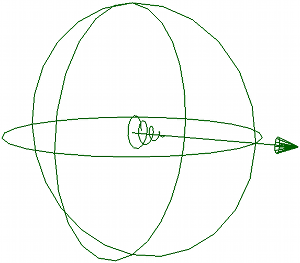To create a vortex control object: Choose Get  Force
Force  Vortex from the Simulate toolbar, Get
Vortex from the Simulate toolbar, Get  Primitive
Primitive  Control Object
Control Object  Vortex from the other toolbars, or Create
Vortex from the other toolbars, or Create  Force
Force  Vortex from the Hair toolbar.
Vortex from the Hair toolbar.
To redisplay this property editor: Select the vortex object and press Enter.
The Vortex force simulates the swirling movement of a vortex on ICE particles, rigid bodies, and hair.
Vortex has no effect on Soft body or Cloth simulations.
For more information on forces in general, see Forces [ Simulation].
To use this force in an ICE tree, see Creating and Applying ICE Forces to ICE Simulations [ICE Fundamentals].

Length of the arrow is determined by the Amplitude value. Radius of the sphere is determined by the Range value when Local is selected.
vPos = particle's position vector
vVel = particle's velocity vector
vForce = the new force
length = vPos.length // two steps 1. radialDecay = length / range 2. radialDecay = (decay >= 0) ? (1 - radialDecay) ^ decay : radialDecay ^ -decay intensity = amplitude * radialDecay vIntensity = (intensity, 0, 0) vDirection = crossProduct(vVel, vIntensity) vRadialDir = (5 * radial) * ( normalize(0, vPos.Y, vPos.X) ) vForce = vRadialDir + vDirection
If Local is not selected (global):
length = intensity / (1 + vPos.length ^ 3) vDirection = cross(vVel, vPos) vRadialDir = radial * ( normalize (vPos) ) vForce = intensity * (vRadialDir + vDirection)